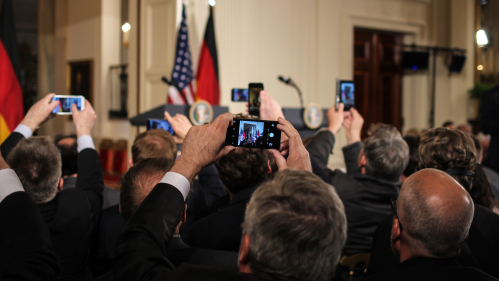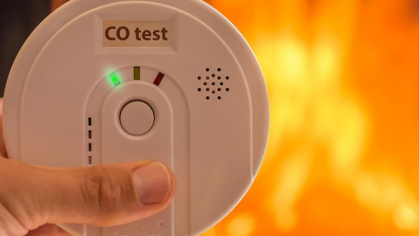How Trump Shaped the Media

Two generations ago, Walter Cronkite was the most trusted man in America.
Today, four years after outgoing President Donald Trump and right-wing media outlets began calling mainstream media the enemy of the people, millions of Americans question the validity of the news they are watching and reading.
Rutgers Today talked with Khadijah Costley White, assistant professor of journalism and media studies with the School of Communication and Information at Rutgers-New Brunswick and author of Raising the Volume: How the News Media Created the Tea Party about how the Trump presidency shaped a media weakened by decades of deregulation and the monopolies more interested in making a profit than protecting the public interest.
Donald Trump worked to discredit journalists throughout his presidency, labeling the mainstream media biased. His claims of “fake news” have caused large swaths of the public to lose trust in mainstream media. What are the consequences of his actions?
The right has always complained the media is biased against them, even before Trump got into office. At their best, journalists imagine themselves as the fourth estate, providing checks and balances for those in power. It is the journalist's responsibility to inform the public so they can go into a voting booth and make decisions as a nation. Trump and his encouragement of retributive violence towards perceived opponents has made it more difficult for reporters to do their jobs and show up at events out of fear for their safety.
What led to the proliferation of propaganda media outlets that supported the Trump administration with “alternate facts” and far-right outlets that peddled white supremacy and anti-Semitic conspiracy theories?
In the 19th century journalism was somewhat similar to how it is today with tabloids run by various groups vying for political and media power. But in the early 20th century, as communication technology expanded, news chains started to insist on standards and routines that would appeal to a wider audience. Journalism began the process of professionalization through universities and the creation of professional codes and ethics. Congress created the Federal Communications Commission in 1934 to guard the national public interest. Broadcasters were required to serve the public in some capacity or possibly lose their license. The FCC was trying to grapple with the power of the media to ensure it wouldn’t undermine the nation.
What changed?
For a long time, TV news was not seen as a marketable or a profitable industry. Then in the 1970s and ’80s, the FCC began taking a much more neoliberal approach to policy that let the marketplace decide how media should look instead of regulators and politicians. The bulk of the fairness doctrine was effectively struck down and commitment to protecting public interest declined. When broadcasters started realizing they could make money off TV news, we saw a shift in programming with the introduction of A Current Affair and other shows like it. Then came the Telecommunications Act in 1996, which Bill Clinton signed, allowing media monopolies and conglomerates to grow massively, reducing the control of the media to a few select people. Soon after that Fox News was born.
How did that deregulation foster the spread of disinformation – most recently about COVID-19 and the legitimacy of our election – during the Trump administration?
Over the last several decades, producers of broadcast news became much more interested in serving a wealthy audience who could purchase things, shifting the notion of the audience and the delivered content. Being privately owned and controlled by billionaires also changed the news landscape – pushing back science, more siloed media, less ethics or restrictions and the continued circulation of fake news and conspiracy theories confirmed biases many already had. All of this helped Trump use the media to his own advantage to manipulate conservatives and news makers alike.
President Obama was the first president to effectively harness the power of social media. Trump is the first president to use it to bypass the media and communicate directly with his base. How has that shaped media coverage of the White House?
So through social media, high-profile folks get to manage their brand without talking with journalists who will make them answer questions. The result is that the press feels like they have to fight for access and are more likely to frame their coverage in ways that give them access instead of ways that help the public. That’s why Trump losing twitter is a huge hit.
I think in the past, presidents have done their best to put out accurate information because they believe putting out clear lies would undermine their credibility and political career. Trump’s support was cultivated around his brand – white supremacy, wealth and greed – so as long as he stayed loyal to his brand, his accuracy wasn’t so important to his supporters. Plus his strategy involves saying two contradictory things about the same issue – for example, saying “stand by” to the Proud Boys and “We love you” to the insurrectionists, followed by messages eschewing violence. That way his supporters can grasp onto whichever message they like best.
Instead of taking a hard stand on what they will and won’t accept from the president, the White House press corps often normalized his tactics and those of his alt-right administration through coverage.
How can mainstream media avoid being manipulated by future politicians in the same way?
The leaders of the major networks need to come up with clear norms around who they give coverage to, what they will and won’t allow, and they need to agree to them. No president should have been screaming at reporters not to wear masks at press conferences. That’s a direct endangerment of your own employees. If you have someone who demonstrably lies to the press, then you don’t allow them unfiltered news coverage or soundbites. You don’t get to be followed by news employees who have to trail the president like paparazzi if you are treating our employees this way. There needs to be a new code of ethics developed among these corps. When you treat Stephen Miller, who by most definitions is a Neo Nazi, like a nice guy just getting married in a New York Times wedding announcement, it lends credibility and legitimacy to his politics, too.
Are regulations the answer?
I think more regulation is better. There needs to be a truly public journalism source. In the UK you have the BBC, which is primarily government funded, so they have more freedom from advertisers. We have PBS and NPR, but they get very little public funding. They are very much beholden to the taste of their sponsors and audience, which is largely white and middle class. I think the other solution is appointing a FCC that once again believes the public interest should be at the forefront of communication policy rather than commercial interests and profits.
Can the media rebound from the damage inflicted by the Trump presidency?
Trump has been a test for American democracy. He’s done all he can to expose the weakness of our institutions that should govern media, politics and executive branch behavior. If the Biden administration takes seriously the need to respond to these tests and bolster and build what’s weak, it could be a really incredible administration and super valuable for the integrity of our democracy.


